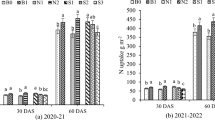Abstract
Two trials inPinus radiata growing on different sites in N.S.W. allowed consideration of fertilizer applications after 2nd or 3rd thinning. The trials included factorial applications of N and P at a single thinning intensity plus a further treatment which allowed assessment of different thinning intensities. The most significant growth responses were obtained by application of N and P in combination. The largest response (additional productivity compared with the unfertilized control) occurred 4 years after application and after 7 years there was no additional absolute response for either of the two sites. The largest fertilizer response was 70 m3 ha−1 over 7 years on one site and 36 m3 ha−1 on the other, indicating differences in absolute responses between sites. It was concluded that in planning treatments the most responsive sites near the end of the rotation should be selected to maximise economic returns. Foliage analyses indicated differences between sites at the commencement of the study. It was concluded that either a single year of foliage analyses at study commencement is of value, or sampling every year of the study should be used to analyse responses, but a single year of analysis during or at the end of the study would not be of value.
Similar content being viewed by others
References
Crane WB (1983) Growth following fertilization of thinnedPinus radiata stands near Canberra in southeastern Australia. Aust For 44: 14–25
Gessel SP and Atkinson WA (1984) Use of fertilizers in sustained productivity of Douglas-fir forests. pp. 67–87. In: Stone EL (ed) Forest Soils and Treatment Impacts. Proceedings Sixth North American Forest Soils Conference
Lambert MJ (1986) Sulphur and nitrogen nutrition and their interactive effects onDothistroma infection inPinus radiata. Can J For Res 16: 1055–1062
Lambert MJ and Turner J (1988) Interpretation of nutrient concentrations inPinus radiata foliage at Belanglo State Forest. Plant Soil 108: 237–244
Peterson CE, Ryan PJ and Gessel SP (1984) Response of Northwest Douglas-fir stands to urea. Correlation with forest soil properties. Soil Sci Soc Am J 48: 162–169
Peterson CE and Hazard JW (1990) Regional variation in growth response of coastal Douglas-fir to nitrogen fertilizer in the Pacific Northwest. For Sci 36: 625–640
Sokal RR and Rohlf FJ (1969) Biometry — the principle and practice of statistics in biological research. WA Freeman and Co, San Francisco
Snowdon P and Waring HD (1990) Growth responses byPinus radiata to combination of superphosphate, Urea and thinning type. For Ecol Manage 30: 313–325
Turner J and Lambert MJ (1986) Nutrition and nutritional management ofPinus radiata. Ann Rev Ecol Syst 17: 325–350
Turner J and Lambert MJ (1987) Nutritional management ofPinus radiata at Gurnang State Forest, New South Wales. Fert Res 13: 127–137
Turner J, Lambert MJ and Gessel SP (1988) Nitrogen requirement in young Douglas-fir of the Pacific Northwest. Fert Res 15: 173–179
Woollons RC and Will GM (1975) Increasing growth in high production radiata pine stands by nitrogen fertilizers. NZ J For 20: 243–253
Author information
Authors and Affiliations
Rights and permissions
About this article
Cite this article
Turner, J., Lambert, M.J., Bowman, V. et al. Two post thinning fertilizer trials inPinus radiata in New South Wales, Australia. Fertilizer Research 32, 259–267 (1992). https://doi.org/10.1007/BF01050363
Received:
Accepted:
Issue Date:
DOI: https://doi.org/10.1007/BF01050363




